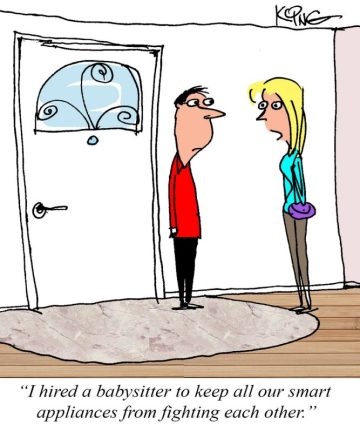Home
Choices (and prices) abound with vacuums
If you’re thinking about replacing your old, broken-down vacuum cleaner, get ready for a dizzying array of options at a huge variety of price points.
Budget or high-end models, bagless, cordless, robotic, allergy-friendly — today’s vacuum cleaners aren’t like your grandmother’s heavy old upright model.
Cordless vacuums offer a lightweight, versatile alternative to the bulky corded appliances of the past, and the newer models can handle all types of flooring and other cleaning projects with the same power as a corded vacuum. The lighter weight and maneuverability are great for homes with lots of stairs. But buyers should be aware — these vacuums often have lower debris collection capacity than their corded counterparts, and without regular charging, a low battery could interrupt your housecleaning.
A high-end model like a Dyson V15 is priced around $700, while a more affordable cordless vacuum like the Moosoo M X6 still offers great cleaning power for a much more affordable $90.
Bagless vacuums substitute the traditional vacuum bag with a clear chamber where debris collects. When the chamber is full, simply dump it in the trash. They’re a lower waste and less expensive to operate than vacuums that require bags, but for allergy sufferers, the increased exposure to allergens — especially when emptying the chamber — might make this a non-starter. A higher-end model like the Sharp APEX costs around $390, while the Bissell Cleanview will run you about $80.
Robot vacuums, unlike humans, never forget to vacuum the carpet and can usually be relied upon to find hidden crumbs behind the sofa and those pesky clumps of pet hair. Some of the latest models can even mop and empty themselves. But the dust collection bins have limited capacity and the robots aren’t ideal for multi-level homes with lots of steps. If you’ve got deep pockets and want a robot that empties itself, try the iRobot Roomba s9+, which retails for about $950. The iLife A9, however, still does a good job on the low-pile carpet for a more affordable $220.
If you have asthma or allergies, you may want to purchase a vacuum with a HEPA filter to keep the air around the vacuum free of flying dust, dirt, pet hair, dander and other indoor air pollutants that might go airborne while you’re sweeping. The Miele Complete C3 canister vacuum offers HEPA filtration and a sealed air system to avoid kicking up extra dust particles and runs about $1,100. The Hoover WindTunnel 3 High-Performance Pet upright vacuum also offers HEPA filtration, as well as extra features to get pet hair off the floor — all for about $200.
Home
Container Gardening: A Versatile Option for Every Space
Looking to add a splash of color and life to your outdoor living area? Consider the vibrant and versatile option of container gardening. Perfect for both houses and apartments, container gardens can enhance any space, allowing you to enjoy lush greenery and colorful blooms inside or out.
According to experts from the Horticulture Gardening Institute at Michigan State University, container gardens are beautiful and practical, making gardening accessible to everyone regardless of the size of their outdoor space. Here are some essential tips to get you started:
- Choose Compatible Plants: Selecting plants that thrive under similar conditions is crucial. Group together those that require the same amount of sunlight, shade, and water. This ensures all your plants are happy and healthy, minimizing maintenance hassles.
- Opt for Long-lasting Blooms and Textured Foliage: Choose flowers that bloom for extended periods and foliage plants that offer varied textures and colors to maximize your garden’s visual appeal. These plants will keep your space lively and attractive throughout the seasons.
- Regular Watering is Key: Containers may dry out faster than traditional garden beds, especially during warm weather. Watering frequency can depend on the container’s material, size, location, and prevailing weather conditions. It’s advisable to check your plants regularly and water them as needed, whether daily or twice daily during peak summer days.
- Fertilize for Best Results: Feeding plants is essential to promote healthy growth and vibrant blooms. Use a water-soluble all-purpose or bloom-booster fertilizer every 10 to 14 days. This will help replenish nutrients in the soil, which can be quickly depleted in a container setting.
Container gardening offers a flexible solution to bring nature closer, whether you want to decorate a small balcony or a spacious backyard. With these expert tips, you’re well on your way to creating a stunning garden that reflects your style and perfectly fits your living space. Happy gardening!
Home
Stay Safe During Spring Yard Work: Tips for Common Hazards
Spring brings glorious weather and the opportunity to tackle yard work like mowing, gardening, and trimming. However, it’s important to stay mindful of safety hazards. The American College of Foot and Ankle Surgeons highlights the dangers of power mowers, injuring around 80,000 people annually. Here are some safety tips to keep in mind before diving into your spring chores:
- Get a Tetanus Shot:
Tetanus can cause serious health issues, including jaw spasms, muscle convulsions, and death. Make sure your tetanus shot is up to date. - Use Caution with Power Mowers:
Wear hard-toed shoes and keep children and pets away. Clear the yard of objects that could become dangerous projectiles when struck by the mower. - Use Ladders Safely:
Falls from ladders are common during spring tasks like tree trimming and gutter cleaning. Climb ladders empty-handed and have someone pass you tools once you’re in place. - Check Your Chainsaw:
Make sure both you and your chainsaw are in good condition before use. Never climb a ladder while holding a chainsaw or any sharp object. - Consider Hiring Professionals:
For tasks that require a lot of climbing or specialized skills, hiring professionals can ensure the job is done safely and correctly. - Lift Properly:
When moving heavy bags, lift with your legs by bending at the knees and lifting from within your feet’s span. Use carts or wheelbarrows to transport heavy items over longer distances. - Use Ergonomic Tools:
Opt for tools with ergonomic grips to prevent wrist injuries. Rakes, shovels, and trowels with arm fittings can make gardening safer and more comfortable.
Following these tips can help you enjoy your spring yard work while minimizing the risk of injury.
Home
Declutter Your Home with Smart Storage Solutions
Is your living space starting to resemble an obstacle course filled with clutter? It’s time to reclaim your home and enjoy the tranquility of a tidy, organized environment. You can efficiently organize your belongings and say goodbye to clutter with the right storage solutions. Here are some effective strategies to help you get started:
Transform Your Wardrobe with Organizational Systems
The key to a clutter-free bedroom starts with your wardrobe. Explore the wide range of organizational tools available at local hardware and big-box stores. These solutions can help you neatly store your clothing and accessories, from hooks and shelves to shoe racks and bins. An organized wardrobe saves you time and makes your space more inviting.
Opt for Multifunctional Furniture in the Living Room
Furniture that serves multiple purposes can significantly enhance your living room’s functionality and aesthetics. Consider a coffee table with built-in drawers and compartments for easy storage of remotes, books, and other small items. Ottomans with hidden storage compartments are perfect for tucking away magazines and throw blankets, while sofa beds with drawers offer an extra storage solution for linens and pillows. These pieces of furniture help keep your living area tidy and guest-ready at all times.
Utilize Innovative Bathroom Accessories
Maximize your bathroom’s storage potential with smart accessories designed to keep personal hygiene products organized and out of sight. Trays with dividers are great for organizing smaller items like toothbrushes and cosmetics, while towel bars and shelves offer a sleek way to store towels and washcloths. Don’t overlook the potential of vertical space; wall-mounted shelves and over-the-door storage can be lifesavers in smaller bathrooms.
Explore Local Shops for Creative Storage Ideas
Don’t stop at these suggestions—venture into your local shops to discover more clever storage solutions. Whether it’s a unique piece of furniture with hidden storage or an innovative organizational system, there is a world of options to help you maintain a clutter-free home.
A well-organized home looks great and promotes a sense of calm and order. By implementing these simple yet effective storage solutions, you can enjoy a cleaner, more organized living space that reflects your personal style and meets your daily needs. Start decluttering today and transform your home into a haven of tranquility and efficiency.
Home
Mastering the Art of Stain Removal: Home Remedies for Stubborn Stains
Dealing with stains can often feel like a battle, especially when it comes to substances that are notorious for leaving their mark, such as red wine, pen ink, coffee, and blood. But fear not! The world of home remedies offers several effective solutions to tackle these stubborn stains, restoring your fabrics and other materials to their former glory. Here’s a guide to some of the most common stains and how to remove them using ingredients likely already in your home.
Red Wine Stains
Red wine spills are a common party foul, but they don’t have to spell disaster for your fabrics. A mixture of baking soda and lemon juice can work wonders. Apply it generously over the stain and let it sit for about an hour before rinsing with cold water. Dabbing with white vinegar before rinsing can also be effective for dried stains.
Pen Ink Stains
Ink stains from a leaking pen need not be a death sentence for your clothes. Applying white toothpaste (not gel) or rubbing alcohol to the stain and rubbing vigorously can lift the ink. Alternatively, a paste made from milk and cornstarch applied to the stain and brushed off once dry can also be effective.
Coffee Stains
Coffee stains are a common morning mishap. To treat them, blot the stained area with a mixture of lukewarm water, dishwashing soap or laundry detergent, and white vinegar. Let the mixture sit for a few minutes, then wash as usual. For persistent stains, gently dabbing with rubbing alcohol can help remove any lingering discoloration.
Blood Stains
Dried blood stains can be particularly challenging. Soak the stained area in cool water mixed with white vinegar for about 15 minutes, then blot and rinse with clean water. It’s important to use cool water, as hot water can set the stain, making it nearly impossible to remove.
The Joy of Stain Removal
The process of removing a stubborn stain can be incredibly satisfying, transforming a marred item back to its pristine state. These home remedies not only save you a trip to the professional cleaner but also offer a sense of accomplishment in easily tackling household chores. Next time you’re faced with a daunting stain, remember these tips and relish in the satisfaction of making it disappear.
Home
Streamlining Home Renovations: Effective Storage Solutions for Your Belongings
Embarking on home renovations can transform your living space into a dream abode, but it also brings the challenge of safeguarding your belongings during the process. Whether you’re knocking down walls, updating your kitchen, or adding an extension, significant renovations mean you’ll need a safe spot for your furniture and other items to avoid damage and clutter. Here’s how to ensure your belongings are securely stored, making your renovation project smoother and protecting the items you love.
Choosing the Right Storage Option
- Professional Moving and Storage Services: Many moving companies offer storage solutions tailored for homeowners undergoing renovations. This option is particularly handy because it combines moving and storage, reducing the hassle of dealing with separate entities. Ensure the company is reputable and offers conditions like climate control if needed for delicate items.
- Self-Storage Units: Renting a self-storage unit provides flexibility and accessibility. Whether you need a locker for a few boxes or a mini-warehouse for an entire household, you can select the size that suits your needs. Look for facilities with strong security measures, such as surveillance cameras and controlled access, and consider the location carefully to ensure it’s convenient for frequent visits.
- On-Site Storage Containers: For those who prefer to keep their belongings close, renting a storage container that can be placed on your property is an excellent solution. This option offers easy access to your items whenever you need them. However, check your local zoning regulations and homeowner association rules to avoid any legal issues.
Making the Smart Choice
When deciding among these options, consider factors like the duration of your renovation, the value and sensitivity of your items, and how often you’ll need access to them. Additionally, weigh the convenience and cost of each storage solution against your project’s overall budget and timeline.
Protecting Your Belongings
Regardless of the storage option you choose, take steps to ensure your items are protected:
- Insurance Check: Verify with your insurance provider that your belongings will be covered while in storage. Some policies may require additional riders or adjustments for off-site storage.
- Secure Packing: Invest in sturdy boxes, quality packing materials, and take the time to pack your items carefully, especially fragile ones. Labeling boxes can also save you time and frustration when you’re ready to unpack.
- Regulatory Compliance: If opting for an on-site container, familiarize yourself with any local regulations or restrictions to ensure compliance and avoid fines or complications.
Conclusion
Renovations are an exciting time of transformation for any homeowner. By choosing the right storage solution for your belongings, you can ensure that the process is as stress-free as possible. Whether you opt for professional storage services, a self-storage unit, or an on-site container, the peace of mind knowing your items are safe and sound lets you focus on the exciting changes happening in your living space.
Home
The Ultimate Pantry Cleaning Guide: 7 Steps to Refresh Your Space
Tackling your pantry might seem like a daunting task, especially if it’s been a while since its last deep clean. However, with a systematic approach, you can transform this chore into a satisfying project. Whether you’re a seasoned home chef or someone who loves a well-organized space, follow these seven steps from cleaning and organization professionals to clean your pantry like a pro.
1. Empty Your Pantry
Begin by removing everything from your pantry. This step not only allows you to see all the items you have but also enables you to clean the space thoroughly. You might even find some hidden treasures or forgotten items in the process!
2. Sort Food by Category
Once everything is out, categorize your items. Group spices together, place all canned vegetables in one area and gather your cereals. This categorization will make organizing and locating items easier once they’re back in the pantry.
3. Check Expiry Dates
Go through each item and check its expiry date. Dispose of anything that’s out of date. For items without visible expiry dates, use a reliable source to check their shelf life. Ensuring that your pantry is free from expired goods is crucial for health and safety.
4. Clean Shelves and Walls
With the pantry empty, take the opportunity to clean the interior thoroughly. Use an all-purpose cleaner to wipe down the walls and shelves. This step helps remove dust, crumbs, and any spills, creating a clean base for your items.
5. Wipe Down Containers
Before putting items back, wipe down the outside of plastic and glass containers and bottles. This helps keep your pantry looking clean and ensures no sticky residues are transferred onto the shelves.
6. Organize Items Strategically
As you return items to the pantry, think about their placement. Keep frequently used items at eye level and group similar items together, such as canned goods or baking supplies. Consider using storage baskets for smaller items to keep them contained and easily accessible.
7. Clean the Pantry Exterior
Finally, don’t forget about the exterior of your pantry. Wipe down the doors, handles, and any outer surfaces to complete your cleaning project. This enhances the appearance of your pantry and ensures that it’s hygienic from the inside out.
A clean and organized pantry makes meal preparation more straightforward and helps minimize food waste by keeping your ingredients visible and accessible. Plus, the process of decluttering and organizing can be surprisingly therapeutic. So, roll up your sleeves and give your pantry the refresh it deserves. Happy cleaning!








































































